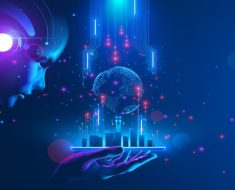Technological companies are estimating the potential of Artificial General Intelligence (AGI), which they consider the zenith of artificial intelligence (AI) development. Although ChatGPT may seem like a giant leap in the world of AI, but it is just the start of an even greater breakthrough — AGI.
In a report published by Stanford University, a team of researchers has concluded that some AI companies may have already cracked the first step to AGI, and may have a working model that can perform at the level of a human.
AGI refers to a machine or a software that can perform any intellectual task that a human can do such as reasoning, common sense, abstract thinking, background knowledge, transfer learning, ability to differentiate between cause and effect.
AGI can emulate human cognitive abilities in a way that it allows it to do unfamiliar tasks, learn from new experiences, and apply its knowledge in new ways.
A human brain uses the information it has gathered to make decisions or solve a problem. An AGI-enabled software or computer will be able to do everything that a human computer does. For example, understanding issues, thinking of solutions and learning new things.
Difference between AI and AGI
The latest generative AI technologies, including ChatGPT, DALL-E are essentially prediction machines, that is, they can predict with the highest degree of accuracy because they have been trained on huge amounts of data. But it is nowhere close to the human level of performance in terms of creativity, logical reasoning, sensory perception and other capabilities.
AGI, however, could feature cognitive and emotional capabilities of a human being.
There are eight capabilities AI needs to master before achieving AGI, as mentioned by a report by McKinsey and Company.
Visual Perception: AI systems still need colour consistency to achieve human-like perception.
Audio Perception: Humans use sound to determine the spatial characteristics of an environment with little to no effort. AI have a more limited ability to extract and process sound, restricted by their hardware and software.
Fine Motor Skills: AI-powered robots have yet to achieve the kind of fine motor skills that a human being can do such as braid a hair or perform a human surgery.
Natural Language Processing: To achieve human-level cognition, AGI would need to consume sources of information such as books, articles, videos. AGI would need to fill the gaps that humans leave when they communicate. Although gen AI tools have demonstrated improved natural language processing, but they still lack understanding and context comprehension.
Problem-solving: AGI should learn from their environment and experience and adapt new situations without explicit programming from humans.
Navigation: Lots of work is required to create robot systems that can navigate autonomously with no human priming.
Creativity: To achieve human-level creativity, AI systems need to write their own code, which will require them to understand the vast amounts of code humans put together to build them and identify ways to improve them.
Social and Emotional Engagement: To achieve a successful human-robot interaction, a robot would need to be able to interpret facial expressions and changes in tone. Some AI are already doing so but to a limited extent.
Inception of AGI
The idea first emerged in the 20th century with a paper written by British mathematician Alan Turing, who was considered to be the father of theoretical computer science and artificial intelligence.
In ‘Computing Machinery and Intelligence’ (1950), he introduced the Turing test, which means, if a machine can engage in a conversation with a human being without being detected as a machine has shown true human intelligence.
The Turing Test is widely used as a benchmark for evaluating the progress of artificial intelligence research, and has inspired numerous studies and experiments aimed at developing machines that can pass the test.
Benefits of AGI
AGI would help perform multiple tasks. For example, in healthcare, it can redefine diagnostics, treatment planning, personalised medicine and analyzing vast data sets.
AGI can enhance more effective learning and improve personalised solutions in the education realm, by creating experiences and services to meet individual needs and preferences. It can revolutionise education, leading to a more knowledgeable and skilled global workforce.
AGI can foster a stronger commitment to ethical AI development, leading researchers and policymakers to remove areas of conflict and align with the ideal values and transparency.
top videos
Reports of NEET-UG Question Paper Leak Are Baseless, Lack Any Ground: National Testing Agency
India Shared A List Of Gangsters And ‘Five Eyes’ Nations Were Not Responding: Sources | News18
Israel Vs Palestine | Israel’s Military Orders Palestinians To Move Out Of Eastern Rafah | N18V
Bengaluru News Today: SIT Announces Helpline For Prajwal Revanna ‘Sexual Assault’ Victims | N18V
ISI Aids Gangsters In Visa Process, Canada-Pakistan Nexus In Play: Top Intel Source | English News
It can play a crucial role in advanced space exploration, discover more life-saving and life-enhancing resources that will lead to all-round economic development. It could lead to a significant further understanding of the universe and other celestial bodies.
OpenAI’s Sam Altman in an interview with The Wall Street Journal said AGI will lead to a “lot of productivity and economic value”, and will be “transformative”, promising unprecedented problem-solving capabilities and creative expression.
first published: May 06, 2024, 16:23 IST

![Large Language Models for Multi-Modal Human-Robot Interaction. (arXiv:2401.15174v1 [cs.RO]) Large Language Models for Multi-Modal Human-Robot Interaction. (arXiv:2401.15174v1 [cs.RO])](https://aigumbo.com/wp-content/uploads/2023/12/arxiv-logo-fb-235x190.png)



